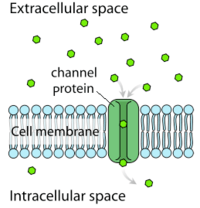
Conduct an Investigation to Demonstrate How the Cell Membrane Maintains Homeostasis Through the Process of Passive Trans
Quiz
•
Biology
•
8th - 12th Grade
•
Medium
+3
Standards-aligned

Charles Martinez
Used 1+ times
FREE Resource
Enhance your content
28 questions
Show all answers
1.
MULTIPLE CHOICE QUESTION
2 mins • 1 pt

How does the cell membrane in the diagram above help to maintain the health of this cell?
By providing support and structure for the cell
By regulating the transport of materials in and out of the cell
By manufactruing protein to provide energy for the cell
By storing food as future energy for the cell
Tags
NGSS.MS-LS1-2
2.
MULTIPLE CHOICE QUESTION
2 mins • 1 pt

Which of the following best explains the process illustrated in the above diagram?
Passage of water molecules through a semi-permeable membrane to equalize concentration
Transport of molecules across a membrane from a high to low concentration gradient by means of a carrier molecule
Movembent of molecules against a concentration gradient expending energy
Separation of suspended particles from a fluid environment through a porous membrane
3.
MULTIPLE CHOICE QUESTION
2 mins • 1 pt
which of the following describes a form of active transport?
Oxygen transfers into red blood cells through small gaps in the cell membrane from oxygen-rich environment surround the cells
Large molecules are brought into the cell by wrapping the cell membrane around the molecules to form a vesicle
water moves across the cell membrane from the side with high osmotic pressure towards the side with low osmotic pressure
membrane proteins provide a pathway for larger particles to move across the cell membrane and bring the cell and environment closer to equilibrium
4.
MULTIPLE CHOICE QUESTION
2 mins • 1 pt
Which of the following describes a form of passive transport?
Membrane proteins act as an enzyme to break down ATP and use the energy to move particles against the concentration gradient.
Large molecules are brought into the cell by wrapping the cell membrane around the molecules to form a vesicle.
Membrane proteins use the energy of the cell's resting potential to move particles against the concentration gradient.
Membrane proteins provide a pathway for larger particles to move across the cell membrane and bring the cell and environment closer to equilibrium.
5.
MULTIPLE CHOICE QUESTION
2 mins • 1 pt
Which of the following describes osmosis?
oxygen transfers into red blood cells through small gaps in the cell membrane from oxygen-rich environment surround the cells
Large molecules are brought into the cell by wrapping the cell membrane around the molecules to form a vesicle.
Water moves across the cell membrane from the side with high osmotic pressure towards the side with low osmotic pressure.
Membrane proteins provide a pathway for larger particles to move across the cell membrane and bring the cell and environment closer to equilibrium.
6.
MULTIPLE CHOICE QUESTION
2 mins • 1 pt
How do cells maintain homeostasis without using energy?
Membrane proteins breakdown moklecules to move other molecules from low concentration to high concentration
Membrane proteins use the negative charge inside of the cell to increase the concentration of a chemical inside of the cell
Maintaining osmotic balance by taking in or releasing water to match the water concentration of the extracellular environment
Form the cell membrane around food to create a vacuole that is kept separate from the rest of the cytoplasm while enzymes break down the food.
Tags
NGSS.HS-LS1-3
7.
MULTIPLE CHOICE QUESTION
2 mins • 1 pt
Due to environmental changes, the water concentration outside of a cell becomes lower than the water concentration inside of the cell. How would the cell most likely respond to maintain homeostasis?
The cell would fill with water
The cell would release water
The cell would increase the production of salt
The cell would decrease the production of salt.
Tags
NGSS.HS-LS1-3
Create a free account and access millions of resources
Create resources
Host any resource
Get auto-graded reports

Continue with Google

Continue with Email

Continue with Classlink

Continue with Clever
or continue with

Microsoft
%20(1).png)
Apple
Others
By signing up, you agree to our Terms of Service & Privacy Policy
Already have an account?
Similar Resources on Wayground

26 questions
Plant Vs Animal Cells
Quiz
•
9th Grade

24 questions
Cell Theory & Pro vs. Eu
Quiz
•
9th - 12th Grade

25 questions
Quiz: Cell Structure & Function
Quiz
•
KG - University

26 questions
Chapter 7.1 and 7.2 review
Quiz
•
9th - 12th Grade

25 questions
Movement in and out the cell
Quiz
•
9th - 10th Grade

23 questions
Cell organelles
Quiz
•
12th Grade

33 questions
Cell Physiology Quiz
Quiz
•
11th - 12th Grade

33 questions
National 5 Biology - Cell transport
Quiz
•
9th - 12th Grade
Popular Resources on Wayground

20 questions
Brand Labels
Quiz
•
5th - 12th Grade

10 questions
Ice Breaker Trivia: Food from Around the World
Quiz
•
3rd - 12th Grade

25 questions
Multiplication Facts
Quiz
•
5th Grade

20 questions
ELA Advisory Review
Quiz
•
7th Grade

15 questions
Subtracting Integers
Quiz
•
7th Grade

22 questions
Adding Integers
Quiz
•
6th Grade

10 questions
Multiplication and Division Unknowns
Quiz
•
3rd Grade

10 questions
Exploring Digital Citizenship Essentials
Interactive video
•
6th - 10th Grade
Discover more resources for Biology

20 questions
Cell Organelles
Quiz
•
9th Grade

20 questions
Cell Transport
Quiz
•
9th Grade

20 questions
Cell organelles and functions
Quiz
•
10th Grade

22 questions
Cell Cycle and Mitosis
Quiz
•
9th Grade

20 questions
Cell Organelles
Quiz
•
9th Grade

25 questions
photosynthesis and cellular respiration
Quiz
•
9th Grade

16 questions
AP Biology: Unit 1 Review (CED)
Quiz
•
9th - 12th Grade

20 questions
Biomolecules
Quiz
•
9th Grade

